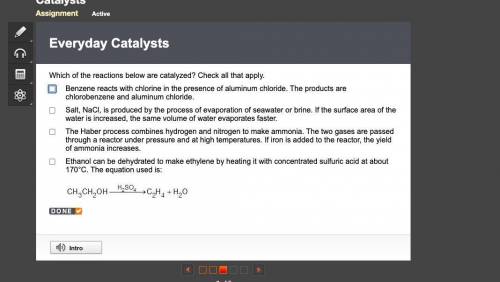Which of the reactions below are catalyzed? Check all that apply.
Benzene reacts with ch...

Chemistry, 29.05.2020 03:57, pizzaboy62
Which of the reactions below are catalyzed? Check all that apply.
Benzene reacts with chlorine in the presence of aluminum chloride. The products are chlorobenzene and aluminum chloride.
Salt, NaCl, is produced by the process of evaporation of seawater or brine. If the surface area of the water is increased, the same volume of water evaporates faster.
The Haber process combines hydrogen and nitrogen to make ammonia. The two gases are passed through a reactor under pressure and at high temperatures. If iron is added to the reactor, the yield of ammonia increases.
Ethanol can be dehydrated to make ethylene by heating it with concentrated sulfuric acid at about 170°C. The equation used is:


Answers: 3
Other questions on the subject: Chemistry

Chemistry, 23.06.2019 10:30, jetblackcap
An atom that gains or loses one or more electrons is called a(n)
Answers: 1

Chemistry, 23.06.2019 12:00, samantha9430
Which of the following involves only abiotic factors? a. a large rock being weathered by wind and rain b. an otter using a stone to break open a sea urchin c. a spider building a web in the corner of a building d. a pine tree absorbing light from the sun
Answers: 1

Chemistry, 23.06.2019 15:30, cicilee49
In a modern periodic table, there are seven periods. a period is any horizontal row of the periodic table, and the elements in a period have consecutive atomic numbers. a group is any vertical column in the periodic table, and there are 18 such groups. groups 3–12, also known as the “b” group elements, are called transition metals. groups 1–2 and 13–18, also known as the “a” group elements, are sometimes called the main groups. metals are characterized by malleability, ductility, conductivity, and a tendency to lose electrons. main group metals are found in groups 1 and 2. nonmetallic elements fall on the right-hand side of the periodic table, that is, groups 13–18. nonmetals have the tendency to gain electrons and are generally brittle. they can be solids, liquids, or gasses at room temperature. now, label the areas of the modern periodic table using the above information. drag the appropriate labels to their respective targets.
Answers: 1

Chemistry, 23.06.2019 19:00, justaguy15
Explain how scientific advancements have lessened the effects of hazardous events on society.
Answers: 1
Do you know the correct answer?
Questions in other subjects:



Mathematics, 20.07.2019 05:30




Mathematics, 20.07.2019 05:30








